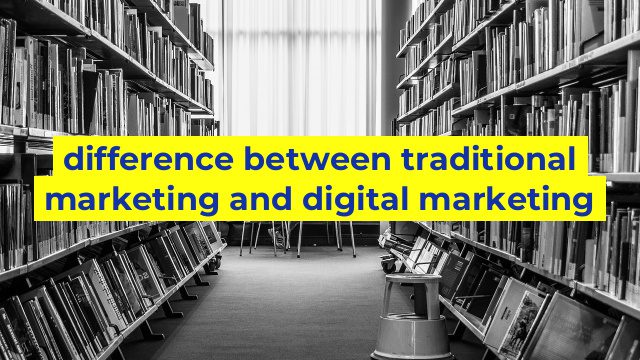Understanding the Key Differences Between Traditional Marketing and Digital Marketing
Marketing is an essential aspect of any business that wants to grow and succeed in today’s competitive market. Traditional marketing and digital marketing are two primary methods that businesses use to get their products or services in front of potential customers. Traditional marketing relies on traditional media channels such as print, radio, and television, while digital marketing involves online marketing techniques such as search engine optimization (SEO), social media marketing, and email marketing.
Reach and Accessibility
One of the biggest differences between traditional marketing and digital marketing is reach and accessibility. Traditional marketing usually has limited reach, and companies can only target specific audiences based on their demographic or geographical locations. On the other hand, digital marketing allows businesses to reach a global audience using the internet, which is accessible to almost everyone.
Cost
Traditional marketing can be expensive, especially when using popular media channels such as television. It usually requires a significant budget to produce and distribute content for TV and print ads. Conversely, digital marketing techniques such as email marketing, social media marketing, and SEO can be substantially cheaper than traditional marketing, and some of these avenues can even be entirely free.
Metrics and Analytics
Traditional marketing campaigns can be difficult to track and measure their success. For instance, it can be challenging to quantify the exact number of people who viewed or converted after seeing a TV commercial. However, with digital marketing, businesses can easily track metrics such as click-through rates (CTR), conversion rates, bounce rates, and more, all of which help them understand how effective a campaign is.
Targeting and Personalization
Traditional marketing usually targets a broad audience and cannot get down to specifics, making it challenging to personalize content for individual customers. With digital marketing, companies can personalize their messages and target specific segments or individuals based on their preferences or buying history. This approach enhances customer engagement and makes digital marketing more effective than traditional marketing.
Flexibility and Scalability
Digital marketing techniques are relatively easy to modify and optimize to suit the needs of a business. Whether it’s adjusting a campaign, adding an email in a sequence or several posts for a social media campaign, it’s easy to make quick updates on the fly. Scaling up or down a digital marketing campaign is also a much more straightforward process than traditional marketing.
In conclusion, while traditional marketing still has its place in the marketing mix, digital marketing is quickly becoming an essential and indispensable tool for businesses of all sizes. With digital marketing’s ever-increasing reach, lower cost, robust measurements, and targeting options, businesses can reduce their ad spend and measure the success of campaigns more accurately. Hence, it’s vital for companies to consider and invest in digital marketing to achieve better results and stay ahead of the competition.
Table difference between traditional marketing and digital marketing
| Traditional Marketing | Digital Marketing |
|---|---|
| Requires physical materials such as posters, flyers, and billboards | Requires digital devices such as computers, smartphones, and tablets |
| Targets a local audience and may not reach a wider audience | Targets a global audience and can be accessed by anyone with an internet connection |
| Less interactive and engaging for the audience | More interactive and engaging through social media, videos, and other content |
| Difficult to track and measure ROI (return on investment) | Easier to track and measure ROI through analytics and other digital tools |
| Relies heavily on cold-calling and traditional advertising methods | Relies on relationships built through online communities and social media |
| May have limited options for targeting specific demographics and interests | Offers a variety of ways to target specific demographics and interests through search engine optimization, social media advertising, and more |
